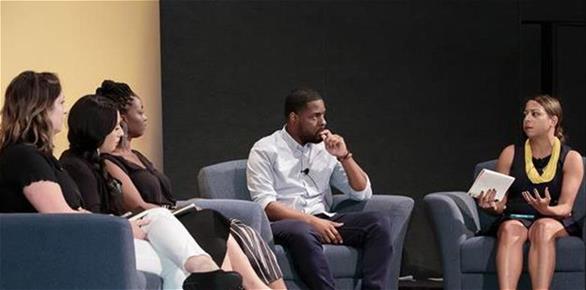
I vividly remember reading The Bully (Townsend Press) in Mrs. Collier-Bacon’s seventh-grade language arts class at Wagner Middle School. As I often mention to my students, Paul Langan’s teen novel was the first time I felt reflected in literature. There was a character who looked like me and shared similar experiences in public education, and that windows and mirrors moment helped me fall in love with literature. After reading this text from the Bluford Series, I read every book I could get my hands on.
At this point, I realized why I wanted to teach. For me, reading was an opportunity to experience life through the eyes of a character, allowing me to escape the reality of violence and poverty in my Philadelphia neighborhood. I began wondering how many lives I could change if I helped other black and brown students, specifically black boys, fall in love with literature.
At the time, I never imagined that I would have the opportunity to join thousands of educators from all over the world at a convening designed not only to unpack new research to support literacy instruction, but also, and more important, to explore the intersections among social-emotional learning (SEL), equity, and literacy.
Our work is interconnected
At the International Literacy Association (ILA) 2019 Conference in New Orleans, LA, in October, I attended the General Session and other keynotes and was moved by the thought-provoking statements shared. Literacy advocate and educator Chad C. Everett asked us to consider how we align the words on a page of a book with words in our world. Nationally Distinguished Principal Hamish Brewer challenged us to think about our legacy: “When you give students the opportunity to read and write, you give them a chance to change the world.”
Brewer’s statement was a recurring theme at ILA 2019. As educators, we understand now more than ever the deep connection between literacy and social action, which is why equity—including ensuring access to literature that provides windows and mirrors—is so important.
Although I had my own presentation to prepare for, I made space to attend Friday’s Equity in Education Program—“The Intersection of Literacy, Equity, and Social-Emotional Learning”—where Pedro Noguera shared a sentiment that teachers have echoed for years: “If you only focus on tests, you’ll fail to provide kids with what they need.”
Later, Justina Schlund from the Collaborative for Academic, Social and Emotional Learning asked educators who are doing the work of SEL to think about their purpose: “Are you doing SEL to produce calm and compliant students? Or do you engage in SEL work to produce active citizens who will be prepared to go out and positively impact society?”
That question resonated with me because too often SEL becomes code for building stronger relationships with students in order to increase compliance, which undermines its essence and purpose.
Later that day, I had the pleasure of sharing my work as a social justice teacher leader and curriculum writer alongside my fellow ILA 2019 30 Under 30 honorees. I met Matt Panozzo and heard how he uses literacy to teach middle school students about identity and empathy in Houston, TX. Patrick Burke discussed his work with teacher preparation programs in Ireland. I spoke at length with Nangamso Mtsatse about the work she is pioneering in South Africa around literacy instruction for elementary students in their native languages. And I was deeply moved by Shontoria Walker’s work with black boys in Texas. Through her research, she found that SEL does affect achievement. Sharing a platform with young educators who have a positive impact on communities around the world was an honor and a privilege.
SEL is deeply embedded in literacy
The next day, I joined Kimberly Eckert, Shawna Coppola, Tamera Slaughter, and Tiana Silvas for the Equity in Education Program event, “Integrating Social-Emotional Learning in the Literacy Classroom.” Eckert reflected on a field trip to a Louisiana prison with her students, where they explored the education system and how SEL permeated the classrooms. Slaughter reminded us that SEL begins with the teacher. We must do the work on ourselves first before we can support our students. Silvas shared powerful stories of her childhood and emphasized how critical providing students with space to share their stories is. And Coppola challenged us to meet students where they are. Storytelling and SEL can look different for all students.
My time at ILA 2019 ended shortly thereafter, but not before I had the pleasure of joining six educators from different states for a collaborative session. We discussed the problems our school communities faced with implementing SEL and proposed solutions that would support our respective schools.
From theory to practice
ILA 2019 reminded me of the direct connection between literacy and social action, and that as educators, we must move with urgency to create academic and professional spaces that are diverse, equitable, and aligned to social action.
When I returned to Philadelphia, I was hyperaware of just how important literacy was in my own school community. I connected with my grade team at The Philadelphia School and challenged them to think about how we can use narratives and discussions in our community meetings to emphasize themes of belonging, diversity, and empathy. We decided to move forward with a nine-session unit on identity development. We chose to push students to grapple with who they are, what experiences and thoughts influence the decisions they make, and the obligations to create inclusive and empathetic spaces within our school community.
My experience challenged me to consider the deep value in creating spaces for educators and researchers to convene. The sessions we attend, the conversations and networking we engage in, and the partnerships we create in those spaces mean nothing if we fail to apply what we learn to how we practice.